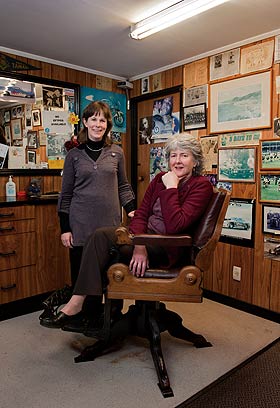

Dr Catherine Smith and Professor Barbara Brookes
Their research highlights how hairdressers adopted new technology with alacrity, unlike their male counterparts – barbers – who struggled with change.
Hairdressing delivered a lot to women over the 20th century – more than simply the hairstyles and the opportunity to look good. It also provided them with new employment and business opportunities.
When new 1920s hairstyles such as the “bob” became the fashion, women needed to have their hair cut and styled and, at that time, the barbershop was the only place a woman could go to find someone who possessed the necessary skills.
Research by the head of the Department of History and Art History, Professor Barbara Brookes, and former doctoral student Dr Catherine Smith has outlined how the women's hairdressing industry started and grew.
The sudden feminine invasion of that masculine domain was not widely welcomed and soon spawned separate salons and new work options for women.
“Up until the late 1930s the main occupation for women was domestic service – very isolated and completely unregulated at the mercy of someone else in a household,” says Brookes.
“For middle-class women the main occupations were teaching and nursing. Then there was factory work or bookkeeping and clerical work. So, in the range of occupations, here was one that allowed you to become your own boss.”
Their research paper – “Technology and Gender: barbers and hairdressers in New Zealand, 1900-1970” – was published in History and Technology (December 2009). Brookes says most historical work on technology talks about men being the adopters of technology, but in the hairdressing industry it was women who adopted technology with alacrity, unlike their male counterparts who struggled with change.
“Perms, dyeing of hair – that was a huge revolution. What is interesting is that the barbers didn't even respond when the men started going to salons in the late 1960s. The barbers were really stuck in what they did and the young men didn't want to go there,” says Brookes.
Smith says that while other women's occupations became less skilled with the introduction of machinery, hairdressers protected and emphasised their identity as skilled workers.
“I think in hairdressing they really kept hold of that identity. They were the skilled workers – they were able to use these things and it was their specialist knowledge that enabled them to do that,” she says.
“What was interesting was the way they fought off threats to it as well; whereas the men generally lost out to the shaving at home, the hairdressers survived the home perm revolution.”
For Brookes, who has been the head of department since 2004, the research into the hairdressing industry has been a logical extension of her previous and current work as an historian.
She came to the department in 1982 and, with Professor Dorothy Page, began the first course in women's history, a field that has since burgeoned.
“Originally I was an historian of women and, subsequently, I have focused on gender – on things where you can actually see men and women and how their careers and lives play out differently, according to gendered norms.
“That's why hairdressing seemed like such a terrific thing to get to that – because hair is the key signal about gender. That's why the 1970s were so confusing; people got very angry because they couldn't tell whether it was a boy or a girl when young men grew their hair.”
She has also been heavily involved in the Caversham Project which resulted in the South Dunedin study “Sites of Gender”, looking at the wide gender differences in a range of areas, from health and accident risks to sporting and leisure activities, as well as gender and language.
Current projects include asylum photography, based around several photographs of a female inmate at the former Seacliff asylum, near Dunedin.
Brookes is also looking forward to writing a book on Dr Anna Longshore-Potts, one of America's first women medical graduates, who toured internationally in the late 19th century doing extensively illustrated talks on medical matters to women-only audiences.
“She did great educational service,” says Brookes. “She also gave lectures to both men and women, but it was the 'ladies only' talks that caused the controversy.”
